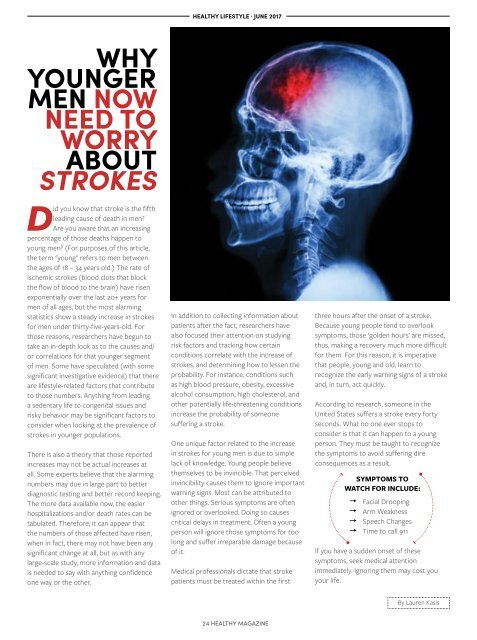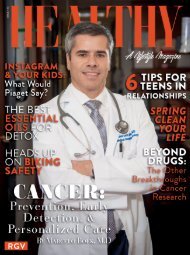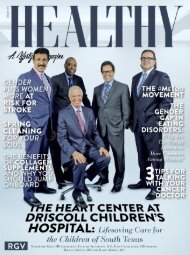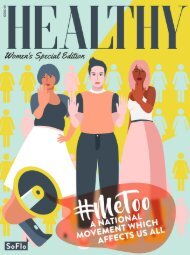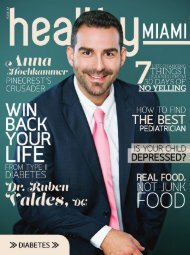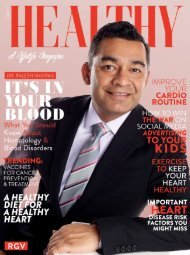Create successful ePaper yourself
Turn your PDF publications into a flip-book with our unique Google optimized e-Paper software.
HEALTHY LIFESTYLE · JUNE 2017<br />
WHY<br />
YOUNGER<br />
MEN NOW<br />
NEED TO<br />
WORRY<br />
ABOUT<br />
STROKES<br />
Did you know that stroke is the fifth<br />
leading cause of death in men?<br />
Are you aware that an increasing<br />
percentage of those deaths happen <strong>to</strong><br />
young men? (For purposes of this article,<br />
the term "young" refers <strong>to</strong> men between<br />
the ages of 18 – 34 years old.) The rate of<br />
ischemic strokes (blood clots that block<br />
the flow of blood <strong>to</strong> the brain) have risen<br />
exponentially over the last 20+ years for<br />
men of all ages, but the most alarming<br />
statistics show a steady increase in strokes<br />
for men under thirty-five-years-old. For<br />
those reasons, researchers have begun <strong>to</strong><br />
take an in-depth look as <strong>to</strong> the causes and/<br />
or correlations for that younger segment<br />
of men. Some have speculated (with some<br />
significant investigative evidence) that there<br />
are lifestyle-related fac<strong>to</strong>rs that contribute<br />
<strong>to</strong> those numbers. Anything from leading<br />
a sedentary life <strong>to</strong> congenital issues and<br />
risky behavior may be significant fac<strong>to</strong>rs <strong>to</strong><br />
consider when looking at the prevalence of<br />
strokes in younger populations.<br />
There is also a theory that those reported<br />
increases may not be actual increases at<br />
all. Some experts believe that the alarming<br />
numbers may due in large part <strong>to</strong> better<br />
diagnostic testing and better record keeping.<br />
The more data available now, the easier<br />
hospitalizations and/or death rates can be<br />
tabulated. Therefore, it can appear that<br />
the numbers of those affected have risen,<br />
when in fact, there may not have been any<br />
significant change at all, but as with any<br />
large-scale study, more information and data<br />
is needed <strong>to</strong> say with anything confidence<br />
one way or the other.<br />
In addition <strong>to</strong> collecting information about<br />
patients after the fact, researchers have<br />
also focused their attention on studying<br />
risk fac<strong>to</strong>rs and tracking how certain<br />
conditions correlate with the increase of<br />
strokes, and determining how <strong>to</strong> lessen the<br />
probability. For instance, conditions such<br />
as high blood pressure, obesity, excessive<br />
alcohol consumption, high cholesterol, and<br />
other potentially life-threatening conditions<br />
increase the probability of someone<br />
suffering a stroke.<br />
One unique fac<strong>to</strong>r related <strong>to</strong> the increase<br />
in strokes for young men is due <strong>to</strong> simple<br />
lack of knowledge. Young people believe<br />
themselves <strong>to</strong> be invincible. That perceived<br />
invincibility causes them <strong>to</strong> ignore important<br />
warning signs. Most can be attributed <strong>to</strong><br />
other things. Serious symp<strong>to</strong>ms are often<br />
ignored or overlooked. Doing so causes<br />
critical delays in treatment. Often a young<br />
person will ignore those symp<strong>to</strong>ms for <strong>to</strong>o<br />
long and suffer irreparable damage because<br />
of it.<br />
Medical professionals dictate that stroke<br />
patients must be treated within the first<br />
three hours after the onset of a stroke.<br />
Because young people tend <strong>to</strong> overlook<br />
symp<strong>to</strong>ms, those ‘golden hours' are missed,<br />
thus, making a recovery much more difficult<br />
for them. For this reason, it is imperative<br />
that people, young and old, learn <strong>to</strong><br />
recognize the early warning signs of a stroke<br />
and, in turn, act quickly.<br />
According <strong>to</strong> research, someone in the<br />
United States suffers a stroke every forty<br />
seconds. What no one ever s<strong>to</strong>ps <strong>to</strong><br />
consider is that it can happen <strong>to</strong> a young<br />
person. They must be taught <strong>to</strong> recognize<br />
the symp<strong>to</strong>ms <strong>to</strong> avoid suffering dire<br />
consequences as a result.<br />
SYMPTOMS TO<br />
WATCH FOR INCLUDE:<br />
pp<br />
Facial Drooping<br />
pp<br />
Arm Weakness<br />
pp<br />
Speech Changes<br />
pp<br />
Time <strong>to</strong> call 911<br />
If you have a sudden onset of these<br />
symp<strong>to</strong>ms, seek medical attention<br />
immediately. Ignoring them may cost you<br />
your life.<br />
By Lauren Kasis<br />
24 HEALTHY MAGAZINE


